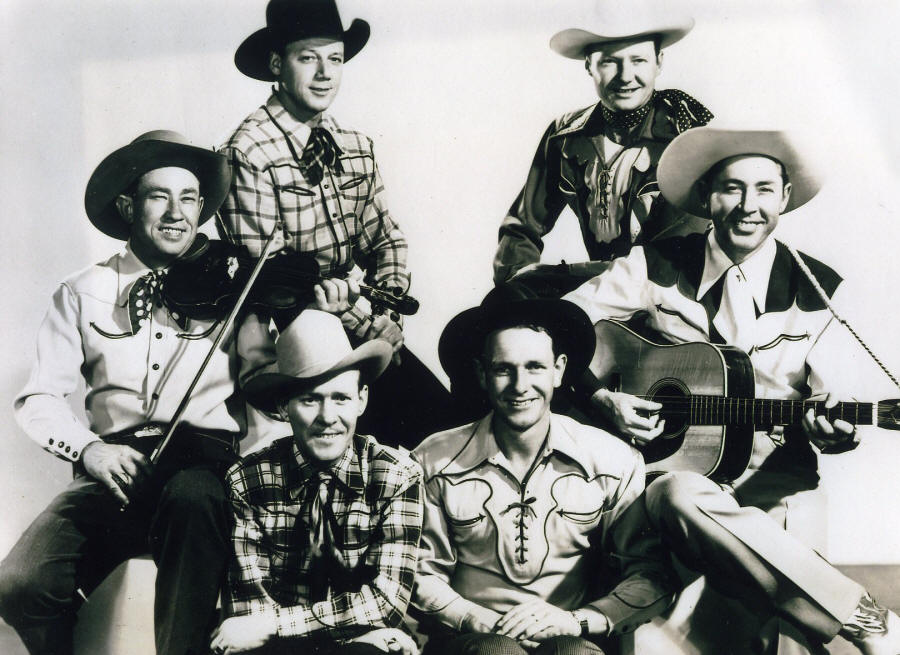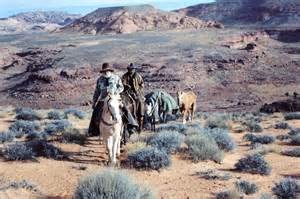 Written by Randle Cecil and Shelby Conine. February 25, 2015
Written by Randle Cecil and Shelby Conine. February 25, 2015
For decades, cowboys worked long hours on even longer cattle drives across vast expanses of the west. The only form of entertainment was to reinvent old folk songs with new lyrics and a beat carried mostly by instruments that were small enough to be carried on horseback, like the harmonica and sometimes a fiddle. However, with the advent of barbed wire in 1867, cattle drives became a thing of the past, forcing cowboys on to ranches. This in turn led to cowboy songs that began incorporating larger instruments, like the guitar, as the cowboy no longer roamed the open west.
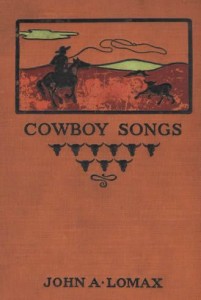 In 1907, Harvard graduate student John Lomax was assigned to study the literature of a particular region and ended up picking the songs of the cowboys. Lomax then toured the region, collecting songs and ballads from any and every one, and put out advertisements in local papers. The response was nearly overwhelming. Three years later, he compiled these songs published them as “Songs of the Cowboy and other Frontier Ballads.” This book broadened the interested in cowboy music and preserved it’s distinct sound at a time when most people were ignorant of its existence.
In 1907, Harvard graduate student John Lomax was assigned to study the literature of a particular region and ended up picking the songs of the cowboys. Lomax then toured the region, collecting songs and ballads from any and every one, and put out advertisements in local papers. The response was nearly overwhelming. Three years later, he compiled these songs published them as “Songs of the Cowboy and other Frontier Ballads.” This book broadened the interested in cowboy music and preserved it’s distinct sound at a time when most people were ignorant of its existence.
Cowboy music took on a life of its own from there as Hollywood took hold of the idea and ran with it. 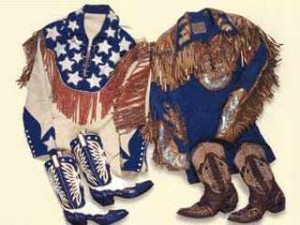 The fascination with “Old Westerns” and cowboy music gripped the country from the 1930s until the mid-1950s, beginning mostly with the film Tumbling Tumbleweeds that starred Gene Autry and contained music from the Sons of the Pioneers, lead by Roy Rogers. Films starring singing cowboys such as Gene Autry, Tex Ritter and Roy Rogers became abundant and featured the actors adorned in big Stetson, western shirts and matching pants and cowboy boots. Beyond the big screen, each of these actors also had a thriving musical career and were very successful, producing hits such as “Back in the Saddle Again,” “High Noon,” and “Happy Trails,” respectively.
The fascination with “Old Westerns” and cowboy music gripped the country from the 1930s until the mid-1950s, beginning mostly with the film Tumbling Tumbleweeds that starred Gene Autry and contained music from the Sons of the Pioneers, lead by Roy Rogers. Films starring singing cowboys such as Gene Autry, Tex Ritter and Roy Rogers became abundant and featured the actors adorned in big Stetson, western shirts and matching pants and cowboy boots. Beyond the big screen, each of these actors also had a thriving musical career and were very successful, producing hits such as “Back in the Saddle Again,” “High Noon,” and “Happy Trails,” respectively.
The image of the cowboy became greatly romanticized during this period mostly due to Hollywood’s adaptation of the cowboy. This image, some believe, was used to fight growing commercialization and was an attempt to be more authentic. The Hollywood cowboy attempted to represent “real” cowboys, but in some ways never quite could. However, the music remained largely the same and very authentic. It included harmonicas, acoustic guitars, fiddles, stand-up bass guitars, and steel guitars. Many singers sang with an accent, or ‘twang,’ while others often yodeled in their recordings and performances.
The subject matter of their songs, though largely about roughing it and the west, sometimes became controversial. In the 1950s, the Sons of the Pioneers began a radio broadcast called “Lucky ‘U’ Ranch.” This broadcast is now regarded as a stand against communism during the Red Scare. It promoted the cowboys moral code as a way to fend off anxieties many held about losing the nations “traditional” values. Moreover, cowboy country welcomed in female performers such as Patsy Montana. She entered the scene in the 1930s with the help of longtime friend Gene Autry. She sang songs about confident, independent women, an idea that was very forward-thinking at the time. She was the feminine counterpart to Gene Autry’s cowboy hero.
Though Cowboy Music saw a decline in the mid-19050s, it was a cultural phenomenon that held the nation during the Great Depression and beyond. The music spoke of traditional values and hard work paying off, giving hope to the hopeless during the economic downturn. The image of the cowboy became a romanticized view of the West and gave confidence during difficult times.
Key Figures
- Gene Autry (1907-1998) Also known as “America’s Favorite Cowboy” was famous not only because of his talent as
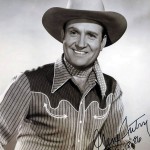 a cowboy singer on the radio and records, but also for his success as a movie star in western films. Autry’s popularity in the 1930s turned hillbilly music into a national sensation. His film career took off with his opportunity to star in Tumbling Tumbleweeds. This film made his work the prototype for musical westerns with featured songs that later became hits. This box-office hit helped him star in nearly 100 movies. Autry’s success spawned a herd of aspiring singing cowboys, such as Tex Ritter and Roy Rogers.
a cowboy singer on the radio and records, but also for his success as a movie star in western films. Autry’s popularity in the 1930s turned hillbilly music into a national sensation. His film career took off with his opportunity to star in Tumbling Tumbleweeds. This film made his work the prototype for musical westerns with featured songs that later became hits. This box-office hit helped him star in nearly 100 movies. Autry’s success spawned a herd of aspiring singing cowboys, such as Tex Ritter and Roy Rogers. - Tex Ritter (1905-1974) starred in more musical westerns than any other singing cowboy before him. He sang in a rich, knotty baritone voice about cattle drives and campfires making him a great performer for cowboy music. His love for western music began while he was studying prelaw at the University of Texas at Austin. Ritter deserted his law career in pursuit of a recording career when he moved to New York and got a job as a singing actor in many western musicals. However, his success was limited at first because the studios he worked for, Grand National and Monogram, were both small and poorly financed. Ritter made a greater impression with his recordings than with his films. His success that spanned over thirty years allowed him to join the Grand Ole Opry in Nashville and the Country Music Hall of Fame.
- Roy Rogers (1911-1998) embodied the perfect cowboy of this time because he was a wrangler, a looker, an actor, and a singer. Better know as “The King of Cowboys”, Rogers was a founding member of the beloved band Sons of the Pioneers. This group, including Rogers, wrote the song “Tumbling Tumbleweeds”, which was the title song for Gene Autry’s first real western film. The Ohio-born cowboy left this group to take Gene Autry’s place at Republic Pictures, where he became a movie star, recording artist, and television star. In many of his films and television episodes, he appeared with his wife Dale Evans, his golden palomino Trigger, and his German Shepard dog Bullet. Along with Autry and Ritter, Rogers helped invent the persona of the singing cowboy.
- Patsy Montana (1908-1996) was a young woman from Hope, Arkansas who eventually became the first singing
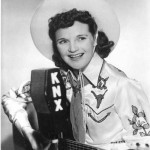 cowgirl star. Montana was the lead singer of the western band Prairie Ramblers. The Ramblers backed Montana on her hit song, “I Want to Be a Cowboy’s Sweetheart” which solidified her credibility of being a true cowgirl performer. This song was the first song created by a female country artist to sell millions of copies. Montana emerged on the scene as a self-determined western heroine whose pursuits in country music were comparable to those of the already known cowboy hero. Patsy Montana, coupled with Gene Autry on many occasions, created romantic representations of the frontier culture. She also broadened the spectrum of gender for her Depression-era audiences by being a strong and independent female artist in a time where this was not as popular.
cowgirl star. Montana was the lead singer of the western band Prairie Ramblers. The Ramblers backed Montana on her hit song, “I Want to Be a Cowboy’s Sweetheart” which solidified her credibility of being a true cowgirl performer. This song was the first song created by a female country artist to sell millions of copies. Montana emerged on the scene as a self-determined western heroine whose pursuits in country music were comparable to those of the already known cowboy hero. Patsy Montana, coupled with Gene Autry on many occasions, created romantic representations of the frontier culture. She also broadened the spectrum of gender for her Depression-era audiences by being a strong and independent female artist in a time where this was not as popular. - Sons of the Pioneers are one of the United States’ earliest western singing groups. Starting in the ‘30s, this group revolutionized western music through their stirring trio and quartet harmonies with a jazz influence. Bob Nolan, a founding member of this group, creating the western hit song “Tumbling Tumbleweeds” along with some help of the other members such as Roy Rogers. The members of the Sons of the Pioneers appeared in many motion pictures as well. The strong influence of the Pioneers continues today with the work of Riders in the Sky and the Sons of the San Joaquin.
Recommended Listening
- “Home on the Range” first recorded by Roy Rogers is often considered the unofficial anthem of the American West. It was included in John Lomax’ “Songs of the Cowboy and Other Frontier Ballads” which was catapulted to fame by president-elect Teddy Roosevelt’s fascination with the song.
- To get a true taste of America’s Favorite Cowboy, Gene Autry, listen to his hit “Back in the Saddle Again.” The song is thought of as Gene Autry’s theme song and he recorded in 1939. It was originally written by Ray Whitley and Autry worked with him to create his final version.
- “I Want to be a Cowboy’s Sweetheart” is one of Patsy Montana’s biggest hits. It was first recorded in 1935 and ultimately became the first country song by a female artist to sell more than a million copies. It was later chosen as one of the Top 100 Western songs of all time by members of the Western Writers of America.
- First released in 1959, “El Paso” by Marty Robbins reached number one on both the pop and country music charts by 1960. It won a Grammy for Best Country and Western Recording in 1961 and was also chosen as on of the Top 100 Western Songs of all time by Western Writers of America.
- Written by band member Bob Nolan, “Tumbling Tumbleweeds” was one of the most famous songs by the Sons of the Pioneers. Nolan wrote it in the 1930s while working as a caddy in Los Angeles. It became the title track for Gene Autry’s first Hollywood blockbuster also titled Tumbling Tumbleweeds. It was later covered by the Cohen Brothers for the movie The Big Lebowski.
Annotated Bibliography
1. Gioia, Ted. “The Big Roundup: John Lomax Roamed The West, Collecting Classic Songs From The Cowboy Era.” American Scholar 74.2 (2005): 101-111. Academic Search Complete. Web. 16 Feb. 2015.
Ted Gioia recalls how John Lomax was the first to gather and publish a book of cowboy songs and music in 1910. His publication, originally an English project at Harvard where he studied as a graduate student, held familiar gems such as “The Streets of Laredo,” “The Old Chisholm Trail,” and perhaps most famously “Home on the Range.” Though there was some copyright trouble with “Home on the Range,” it became the root of the book’s fame after president-elect Franklin Roosevelt claimed it was his favorite song. “The book was a commercial success, but more significantly it was a landmark event in establishing the nation’s [western] music as worthy of study and preservation.” Many of these ballads were actually adaptations from older folk songs brought over by immigrants. For example, “The Streets of Laredo” actually stems from an Irish song, and “Red River Valley” was taken from British troops in Mantioba, the Red River of the North. He then draws links back to the shepherds of old that sang pastoral songs that were nostalgic, lyric-based, and featured yodeling, much like the cowboy songs of the 1930s. Despite blatant disregard of copyright law, Lomax did the more to broaden interest in cowboy music and preserve its distinct sound than anyone else at the time. Lomax was able to capture that sound that was so uniquely western and spoke so honestly about the ideals of work that everyone should aspire to. He was a pivotal man in the widespread fascination that ensued.
2. Oermann, Robert K., and Mary A. Bufwack[DH1] . “Patsy Montana And The Development Of The Cowgirl Image.” The Journal Of Country Music 8.3 (1981): 18-32. MLA International Bibliography. Web. 18 Feb. 2015.
In this article, the authors credit Patsy Montana with developing the cowgirl image, the perfect pair to the well-known rustic cowboy image. Patsy Montana’s most famous song, “I Wanna Be a Cowboy’s Sweetheart”, introduced in 1935, established her credibility of being an authentic and well-respected cowboy music artist. This was the first record by a female country artist to become a runaway hit. With her energetic voice, sparkling yodeling, and wearing her cowgirl outfit, Montana presented a cheerful image during the Depression era with her passion for this subgenre of country, along with her stylish cowgirl outfit. The lyrics of her songs represent independence and love, while also touching on the freedom the cowboy image had come to symbolize. Patsy Montana’s look not only complemented the cowboy image, it also established women as competent and talented cowboy music artists.
3. Peterson, Richard. “Creating Country Music: Fabricating Authenticity.” Journal of American Folklore (1999): 91-93. Print.
Richard Peterson’s book Creating Country Music delves into a deeper and more complex side of country music discussed in the book, rather than giving information about music or musicians. The author believes that, “popular music called ‘country and western’ was not contrived or copied but based on history of real people in the everyday world.” The author also claims that the problem with the country music industry between 1923 and 1953, the cowboy music era, was how to maintain a distinct identity because of the rising commercialization. The main point is that country music has a core concept of authenticity, yet the commercialization of country music blurred the lines of what was actually authentic. This offers a differing viewpoint on cowboy music because he does not describe the rustic cowboy icon as being a distinct identity carried throughout those years.
4. Rothel, David. The Singing Cowboys. San Diego: A.S. Barnes & Co., Inc., 1978. Print.
David Rothel dives into the lives of many famous cowboy music artists in his book,The Singing Cowboys. Gene Autry, Tex Ritter, and Roy Rogers are the artists who we chose to represent this era of country music because of their prominence on the western film scene. Gene Autry’s humble beginnings all the way to his huge success are explained through personal stories about his life, and he was eventually named “America’s Favorite Cowboy” (18). Roy Roger, named “The King of the Cowboys,” along with Gene Autry are described by the author as “the most prolific of the singing cowboys; their films covered an entire span of years (1935-53) that musical westerns were produced” (15-16). They were followed up by Tex Ritter, who never seemed to find his niche on the screen, yet he ironically stared in more musical western films than any other singing cowboy before him. All three of these performers, along with others, helped create the popular cowboy image that dominated many films and songs through many years.
5. Seemann, Charlie. “Happy Trails: The Rise (And Renaissance) Of Cowboy Music.” Will the Circle Be Unbroken: Country Music in America. Ed. Paul Kingsbury and Alanna Nash. New York: DK Publishing, Inc., 2006. 100-25. Print.
Seemann begins by delving into the roots of so-called cowboy country. According to Seemann, it began how one might expect—cowboys on the range made up new lyrics to old tunes as a way of entertaining themselves while they were driving cattle. However, with the advent of barbed wire, the way it was performed began to change. On cattle drives, carrying larger instruments was impractical. However, barbed wire forced cowboys to adhere to fence lines and began a more settled existence, allowing guitars and other large instruments to color the songs. This was a major transition in cowboy music and marks a turning point for country music as a whole. As cowboy country became increasingly established, the country as a whole became obsessed with the idea of the cowboy mostly thanks to Hollywood. In 1929, western films, such as Oh, Susanna!, starring seemingly authentic cowboys were very popular. Thus, a star was born in Gene Autry who “parlayed his success as a star of radio and records into a movie career as the nation’s most popular saddle-riding singer” (107). Many others, such as Tex Ritter and Roy Rogers, followed in Autry’s footsteps and even came to claim his title as America’s No. 1 Cowboy, according to Seemann.
6. Stanfield, Peter. Horse Opera: The Strange History of the 1930s Singing Cowboy. Urbana: U of Illinois, 2002 Print.
This book by Peter Stanfield looks at the singing cowboy phenomenon that fascinated the nation by investigating the Hollywood side of the equation. He explores the 1930s films and their roots in literature, silent film and popular music. In the book, Stanfield argues that the singing cowboy “represented the fantasies, desires, and ambitions of those who felt keenly the economic hardship and the threat of dispossession and dislocation” (2). He examines the lives of the biggest stars, such as Gene Autry, Tex Ritter, and Roy Rodgers, while also discussing the transformation the cowboy went through going into the twentieth century. This transformation, he argues, led to a more broad audience that included the middle-class families that expected less logic in characters and narrative and more emphasis on entertainment value. Hue briefly expands on the musical side of cowboy country by discussing how it was a counter to alternative and jazz and presented a more “benign, respectable, and modern rural identity” (5) than other music styles. Stanfield cements the commonly held belief that cowboy country captured the nation with its traditionalism and romanticism of the west, but he expresses it from the Hollywood perspective which is different than our other sources.
7. Stimeling, Travis D. “The Songs of the Pioneers’ Lucky ‘U’ Ranch and the Singing Cowboy in Cold War America.” American Music 28.1 (2010): 76-96. Print.
Stimeling argues that the Sons of the Pioneers’ radio show “Lucky ‘U’ Ranch,” that began airing in 1951, was a “[response] to growing anti-communikïst sentiments and anxieties about the sanctity of ‘traditional’ American values by promoting the cowboy’s moral code as a weapon in the defense of American values and by invoking nostalgic images of the mythic ‘Old West’ and Depression-era popular culture that stood in stark contrast to the increasingly global visions of postwar America” (77). He views the resurgence in the cowboy image at a time when westerns had been gradually declining in popularity as a symbol for American strength and willingness to support anticommunist activities during the Cold War. The author then delves into the rich history of the Sons of the Pioneers, including their start in 1933 in Los Angeles and their rise to stardom due to the pop vocals and the two very talented songwriters in the band, Bob Nolan and Tim Spencer. The band had its ups and downs and a few transitions in membership, but experienced relative stability from 1935 until 1948. The author goes on to identify the cowboy as one of the most constant characters in American culture, especially after WWII and before the Cold War when the cowboy began supporting the war by singing patriotic songs. The cowboy became a symbol of fierce independence, moral high ground, and community. This work does a lot to supplement the cultural feelings toward cowboy music that a lot of our other articles don’t touch on. It also plants the idea that the cowboy becomes responsive to what the American public needs at any given time in history.
8. Vander Wel, Stephanie. “The Lavender Cowboy and ‘The She Buckaroo’: Gene Autry, Patsy Montana, and Depression-Era Gender Roles.” Musical Quarterly (2012): 207-51. Print.
In this article written by Stephanie Vander Wel, the author describes the impact of the famous cowboy singer Gene Autry and his cowgirl companion Patsy Montana on western music during the Great Depression era. Both of these figures established romantic representations of frontier culture with their sentimental mountain and cowboy songs. Female performers, such as Montana, emerged as “a self determined western heroine whose pursuits of social and material autonomy were comparable to those of the cowboy hero.” However, when the Great Depression hit in the 1930s, men were losing their jobs while women were taking on feminine jobs in the service industries. This change allowed Gene Autry to target his tunes toward lone cowboys trying to make a living, while Patsy Montana targeted females with her songs about confident and free women. Autry and Montana offered hope and promise to their listeners, while also broadening the spectrum of gender for Depression-era audiences. This source shows the impact of cowboy and cowgirl figures that performed songs during important and difficult times in America’s history.
Guiding Questions
- How did Hollywood affect the popularity of Cowboy Country?
- How did the western film industry change the view of the traditional cowboy in the eyes of the American public?
- Why does Patsy Montana qualify to be one of the most important western music performers? How did she change the face of country buy being a woman?
- Three main artists during this subgenre are Gene Autry, Roy Rogers, and Tex Ritter. How are they similar? How are they different?

